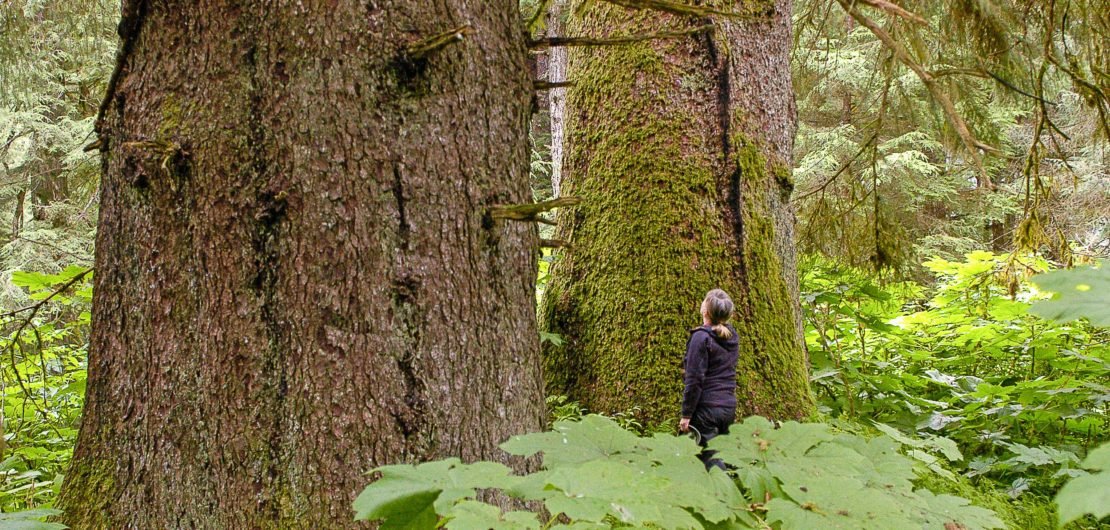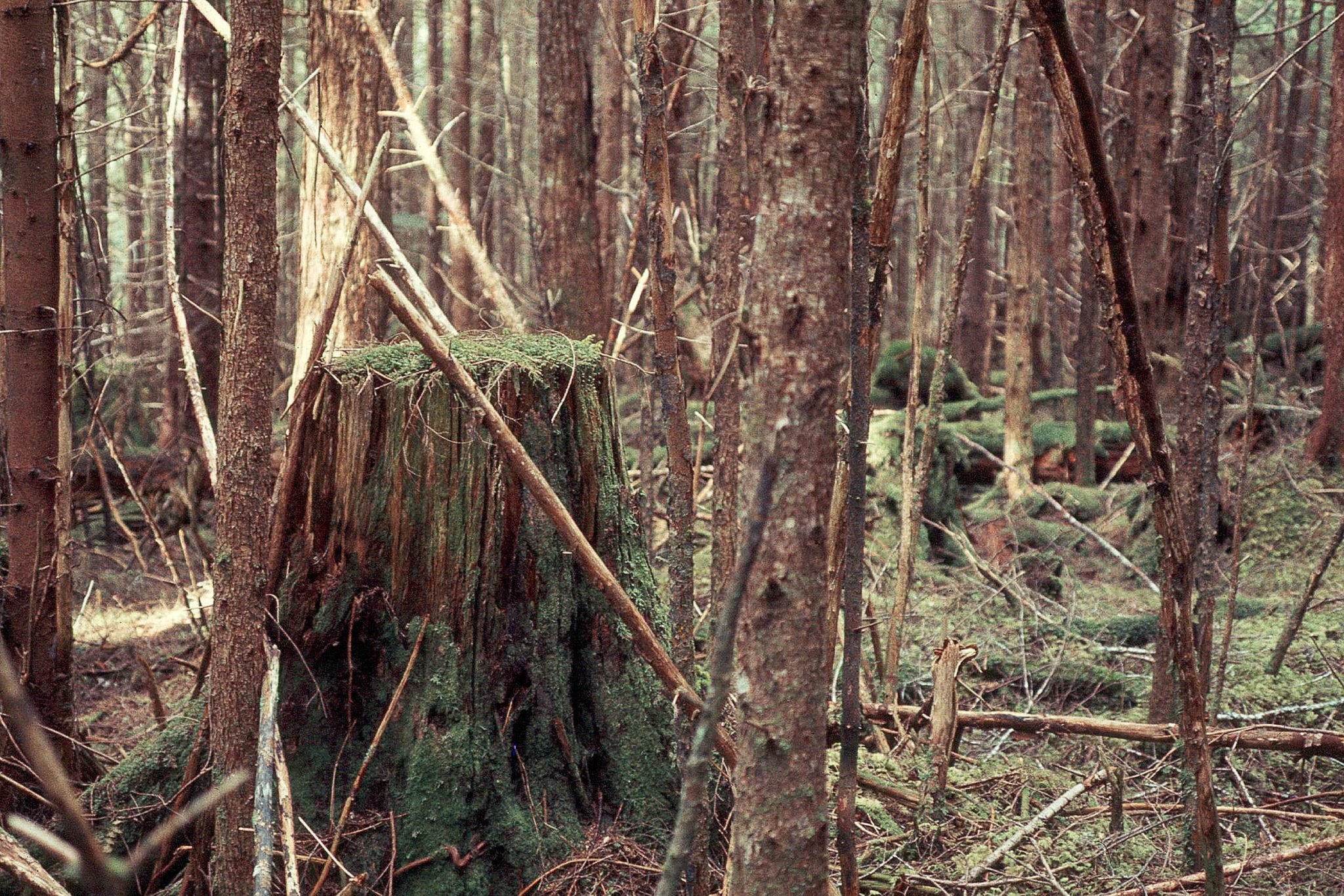‘Tongass Odyssey’ explores decades of research, politics and change
Mary Beth Schoen admiring a large-tree old-growth stand in Saook Bay on northeastern Baranof Island. Some individual trees were over six feet in diameter and many centuries old. This riparian area was adjacent to a salmon stream and was full of bear trails. Large-tree old growth stands are rare on the Tongass. Photo by John Schoen
In 1977, John Schoen flew to Hood Bay on Admiralty Island. He’d been hired as the first Southeast Alaska research biologist to study deer and this was his first trip into the field.
“Flying into the bay, looking at humpback whales and all the bald eagles in the trees… we got out of the Beaver, stepped on the beach and saw these huge, enormous brown bear tracks. And listening to the blue grouse, and the geese on the beach, I just thought ‘Man, I’m getting paid to do this? Unbelievable!’” he recalled.
Biologist John Schoen with the Super Cub on a beach on Admiralty Island. The two antennas under each wing were used to determine which direction had the strongest signal from radio-collared animals. They then could locate the animals within an area about the size of an acre. Photo by John Schoen
Forty-four years later, he’s made a career studying and working to conserve deer, mountain goats, brown bears, and Alaska’s ecosystems, and he’s written a book about the journey: “Tongass Odyssey: Seeing the Forest Ecosystem through the Politics of Trees; A Biologist’s Memoir.”
“What we learned is that old growth forest is very important,” he said of research he did with U.S. Forest Service research biologist Charlie Wallmo and fellow Alaska Department of Fish & Game research biologist Matt Kirchhoff. “Clearcuts were used by deer in the summertime, when there was an abundance of food, but in the winter time, when the snows came, the deer couldn’t use them. In the second growth, the deer would have to pack a lunch to make it through. There’s just nothing on the forest floor.
“One thing led to another. We published our results, and then we took tremendous flak from the Forest Service and the timber industry. I quickly realized that the science was hard to do without bumping into the politics.”
At times, that politics seemed to threaten his job. Twice in the 1980s, he was invited to testify before Congress about his research. Though his immediate supervisors and the then Deputy ADF&G Commissioner were supportive of his work, higher ups in state government were not. The State of Alaska first told Congress he was unavailable — then that there was no money to send him. That wasn’t true. He felt strongly enough about his duty to share what he had learned with the American public that he took annual leave to go testify each time, even taking out a loan to be able to afford the plane ticket.
LaVern Beier, left, and John Schoen, right, with a captured and radio-collared brown bear on a subalpine ridge on northern Admiralty Island above Greens Creek. This 547-pound eleven-year-old adult male bear (#46) was captured in June 1986. Photo by John Schoen
“I just said, you know, if they don’t want me to go back that much and I have done this work on behalf of the public — it’s a public resource — I have to go back (to D.C.). It’s my responsibility,” he said.
As he branched out into researching brown bears and mountain goats and as his knowledge deepened, he began thinking about old growth forest a different way.
“The value
A sixty-year-old second growth forest stand on Admiralty Island. John Schoen measured deer density here in comparison to an adjacent old-growth stand. This is a mixed hemlock-spruce stand in which all the trees are the same age and size. Few forest floor plants occur here because of low light levels. These dark, even-aged stands have low structural diversity and provide relatively poor habitat for most wildlife species. In Southeast, it takes two to three centuries before forests that are clear-cut develop the ecological characteristics of old growth. Note the old-growth stump in the left side of the image. Photo by John Schoen
of old growth isn’t (just) deer habitat. The value of old growth is as an ecosystem. A very unique ecosystem,” he said. “The old-growth forest is a patchwork quilt of all these different kinds of stands, from shore pine to mountain hemlock that may be six inches in diameter and two or three hundred years old. And (different kinds of forest) have a different understory, and they have different values to different species at different times of the year. My evolution has been from looking at the habitat of a single species to looking at the old-growth forest as a very rich, productive ecosystem. People say ‘We’re only logging a small portion of the old growth, so that’s not a problem.’ But they’re focusing that harvest on the rarest, most valuable fisheries and wildlife habitats… Old growth forests are not renewable. You cannot clearcut a forest that has 800-year-old trees in it and expect it to come back in a hundred years to have the same structure and function of an old growth ecosystem.”
A mixed hemlock-spruce old-growth forest stand on Admiralty Island. In comparison to second growth, old-growth forests are uneven aged, with trees ranging from seedlings and saplings to ancient trees and snags that are centuries old. These forests are highly diverse with multiple layers and broken canopies that allow an abundance of sunlight to penetrate the forest canopy, resulting in a diverse and abundant understory of herbaceous and shrubby plants. Dead standing trees and downed logs are important components of old growth and provide valuable habitat. For species like deer, marten, flying squirrels, goshawks, and many cavity nesting birds, old growth provides valuable, if not critical, seasonal habitats. Riparian old growth along streams, rivers, and lakes also contribute to habitat values for many fish and aquatic organisms. Photo by John Schoen
Later in his career, he was the lead scientist for Audubon Alaska. In that role, he organized a letter from seven professional societies representing more than 30,000 scientists to then Secretary of Agriculture Tom Vilsack (whom President Joe Biden has appointed in the position once more) about the importance of transitioning out of old growth clearcutting on the Tongass. They never got a response. But he’s hopeful that the Forest Service policy of allowing clearcut old growth logging on the Tongass will change, especially since even more research is coming out, with a recent study estimating the Tongass stores 44% of the carbon in all U.S. national forests.
Schoen published “Tongass Odyssey” in September of 2020, inspired by people’s shifting idea of what was “normal,” the too-slow pace of change he had seen in 40 years of U.S. Forest Service management of the Tongass, and the endangered status of the Tongass’ remaining large-tree old growth, which represents just 3% of the forest.
“I wrote it because I feel it’s important to get this message out,” he said. “I wanted to put down a marker — here’s what’s happened since I started in 1977. And we still haven’t applied the science that we’ve learned to management. It’s been over 30 years, and we haven’t had the political will…. We still have an opportunity to keep the diversity of forest habitats on the Tongass National Forest. There’s no other national forest in the nation where we have this opportunity.”
Tongass Odyssey was published by University of Alaska Press and is available at your local bookstore, on Amazon, or at https://press.uchicago.edu/ucp/books/book/distributed/T/bo68374362.html.





